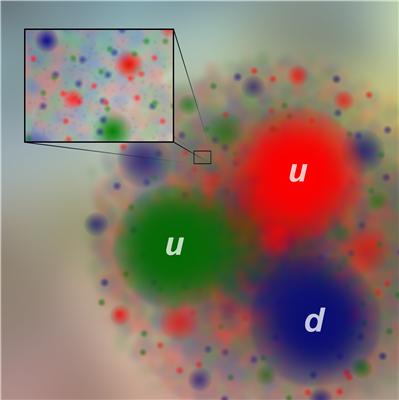Dec 11 2012
Physicists from NCBJ in Œwierk and École Polytechnique (EP) in Paris have theoretically analysed some specific case of electron-proton collisions to help to design an experiment that could deliver new data on proton interior spatial structure.
 Photo: NCBJ
Photo: NCBJ
How does proton interior look like? We should see that at an unheard-of resolution soon. Extremely accurate proton tomography is now possible thanks to theoretical works of some physicists from NCBJ in Œwierk and École Polytechnique in Paris. Their results made possible to plan an experiments that should produce (according to the scientists' hope) some proton cross-section images. The experiment is to be conducted using an accelerator operated in Thomas Jefferson National Accelerator Facility in USA.
To put things simple, each proton and neutron (constituents of nuclei) is composed of three quarks called the valence quarks: two “up quarks” and one “down quark” in a proton, two down quarks and one up quark in a neutron. The quarks are mutually bound with strong nuclear forces.
Strong interactions between quarks are transmitted by gluons described by the quantum chromodynamics theory. According to that theory, gluon field inside a proton must be very strong. "Extremely strong gluon field is all the time spontaneously creating quark-antiquark pairs that are almost instantaneously annihilating. So, interior of each proton is filled up with a boiling sea of virtual quarks and gluons” – explains Dr Jakub Wagner (NCBJ) who – together with Profesor Lech Szymanowski (NCBJ) and Bernard Pire (Centre de Physique Théorique, École Polytechnique) – works on theoretical foundations of the new experiment.
Quark-gluon billows inside each proton seem to be an abstract thing. However, their effects are ubiquitous. Mass of electrons and quarks in atoms is controlled by the famous Higgs mechanism responsible for elementary particle masses. Since electrons are almost 2000 times lighter than protons and neutrons, mass of each atom is almost completely concentrated in its nucleus. "However, total mass of three valence quarks is less than 5% of proton actual mass. The rest is made up by the sea of virtual quarks and gluons boiling inside each proton and neutron”, said Dr. Wagner.
There are also other reasons for which physicists are so much interested in proton internal structure. Origin of proton spin is perhaps the most important among them. Spin of each quantum particle is related to its revolving movements. Spin of each proton and neutron is ½, a not surprising result taking into account that spin of each of the three valence quark of a proton/neutron is ½, too. Such calculations are very rough, no spins of gluons and quarks making up the boiling sea of virtual particles are taken into account. However, with the latter effects taken into account the calculations become so complicated that no one has ever managed to perform them. (Experiments in which origin of proton spin is investigated include for example COMPASS at the SPS accelerator in CERN; NCBJ physicists are involved in that experiment).
Experiments aimed at investigation of proton interior can be traced back to observations of deeply inelastic scattering of electrons on protons started at the end of ‘60 in XX century. In such collisions protons are interacting with electrons only by electromagnetic forces (only a photon is exchanged). Comparing electron observables before and after a deeply inelastic scattering event one can calculate various values, including momenta of particles along the collision direction. In other words, the experiment allowed to observe presence of quarks and gluons, as well as to determine their momenta along the collision trajectory. Unfortunately, no data on transversal components could be concluded so that the experiment did not supply full information on distribution of quarks and gluons in a proton.
In some later experiments physicists were interested in other electron-proton collisions during which ordinary photons were emitted. Both colliding particles and the emitted photons were measured. Sufficient amount of data were acquired to re-create distribution of quarks in the collided proton. The obtained transversal distributions could be interpreted in terms of proton cross-section tomography images.
"Images of proton interiors are re-created from many observations. Therefore they are true only in the statistical sense” – points out Dr Wagner. That principle might be illustrated by the following thinking exercise: suppose we have taken many high-resolution photos of Earth from the Moon. Each photo reveals many satellites, but it would be difficult to guess on the basis of such a single photo what was the idea according to which the satellites were deployed. However, if we put together many photos, we could easily distinguish two layers of satellites: a rather densely populated sphere of satellites orbiting at low orbits, and a circle of geo-stationary satellites “hanging” above the Earth Equator. Space between both layers would be practically empty.
Scientists in Œwierk have been working on theoretical description of another (relatively rare) case of electron-proton collision for may years. The process is similar to that described above, but a highly-virtual photon is also emitted that promptly decays to a pair of leptons, most often an electron/positron pair or a muon/antimuon pair. If properties of all those particles are measured, internal structure of the proton may be re-created with a larger precision then that so far obtainable.
Predictions worked out by theoreticians from NCBJ and EP shall be verified in the newly designed experiment to be soon run in the Jefferson Laboratory, one of the largest labs in the world involved in frontier research at the atomic nucleus/elementary particle physics border. „We are working also on predictions for some experiments to be run in other labs, including the Brookhaven accelerator. Perhaps one of the experiments will be conducted also with LHC participation” – adds Dr. Wagner.
The experiments planned in the Jefferson Laboratory are to be started soon after the accelerator is modernized. Will they answer the question what part of the proton spin originates in the quark/gluon orbital momentum? Most probably the answer will be known not later than in two years.